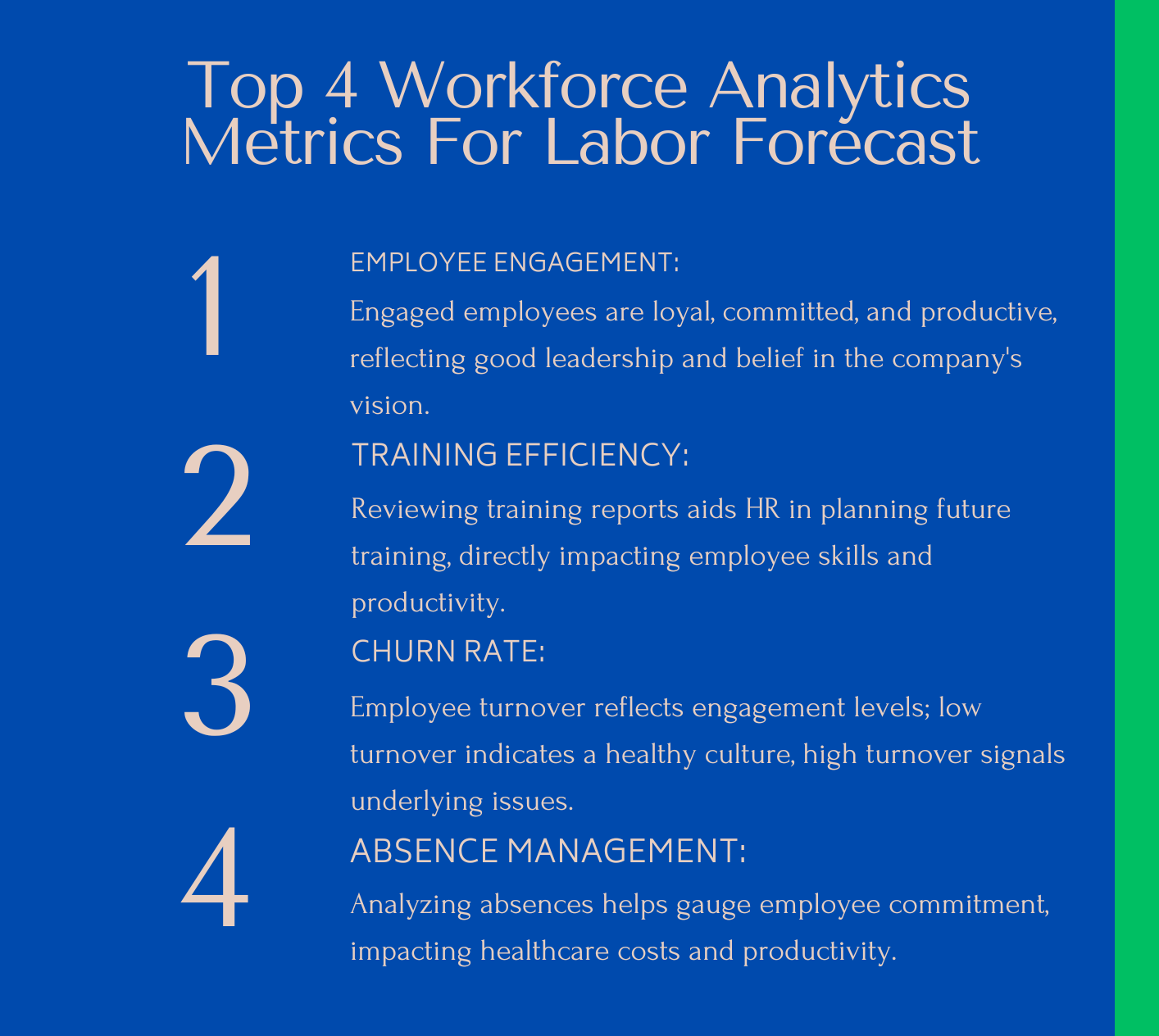Workforce Analytics in Labor Forecasting

Table of contents
- What is Labor Forecasting?
- What is Workforce Analytics?
- Labor Forecasting Techniques
- 3.1. Time Series Analysis
- 3.2. Moving Averages
- 3.3. Exponential Smoothing
- 3.4. ARIMA Models
- 3.5. Causal Forecasting
- 3.6. Regression Analysis
- 3.7. Econometric Modeling
- 3.8. Judgmental Forecasting
- 3.9. Hybrid Forecasting
- 3.10. Simulation Models
- 3.11. Using Machine Learning and Artificial Intelligence
- How Can Workforce Analytics Be Used To Forecast Labor Demand?
- Leverage The True Potential of Workforce Analytics with ProHance
- Frequently Asked Questions
- 6.1. What factors should be considered in labor forecasting and demand forecasting?
- 6.2. What are the benefits of utilizing workforce analytics to forecast labor demand?
- 6.3. Can workforce analytics handle complex workforce demand forecasting scenarios?
- 6.4. Can small and medium-sized businesses benefit from workforce analytics in workforce demand forecasting?
- 6.5. How does accurate labor forecasting contribute to employee satisfaction?
The modern business world is dynamic. In such an evolving business landscape, the importance of precise labor forecasting remains indispensable.
The ability to predict labor demands accurately is a strategic advantage that can drive efficiency, reduce costs, and enhance overall performance. Workforce analytics plays a pivotal role in this endeavor, enabling businesses to make data-driven decisions in labor forecasting.
In this comprehensive guide, we’ll discuss what is labor forecasting, explore various workforce techniques, and finally explore the role of workforce analytics.
What is Labor Forecasting?
Let’s start with the basics- labor forecasting definition. Labor forecasting is the process of predicting your organization’s future workforce needs.
It involves estimating the number of employees required, their skill sets, and the timing of their employment. Accurate labor forecasting techniques are essential for managing workforce supply and demand effectively.
The following statistics highlight the challenges and trends in the modern business industry that mandate structured workforce demand forecasting:
- In 2023, nearly half of employees, specifically 45%, experienced burnout as a result of changes within their organizations.
- Approximately 38% of employees chose to depart from their roles within the initial year of their employment. During this period, employees most commonly cited reasons for leaving as a lack of career advancement prospects, unfavorable job attributes, and an unsatisfactory work-life balance.
- A considerable 32% of workers expressed their desire to maintain remote work arrangements.

What is Workforce Analytics?
Workforce analytics represents the practice of using data-driven insights to make informed decisions about an organization’s workforce.
In labor forecasting, workforce analytics can be applied through various labor forecasting techniques, models, and data sources.
Here are a few workforce analytics related stats, that you should definitely know:
- Merely 16% of employees indicated that they appeared actively engaged in the eyes of their employers.
- The cost of replacing an employee amounts to approximately 33% of their annual salary.
- Roughly 7% of companies that utilize HR technology are actively working to reduce turnover rates.
- More than 75% of the factors contributing to employee turnover can be averted.
- Approximately 81% of employees contemplate leaving their current company if presented with a compelling alternative offer.
Also Read: Change the Way you Approach Workforce Analytics

Labor Forecasting Techniques
Labor forecasting relies on various techniques, each suited to different scenarios. Here are some key methods:
Time Series Analysis
Time series analysis utilizes historical data to forecast future labor needs. This labor forecasting technique involves examining past workforce data, identifying patterns, and projecting them into the future.
Moving Averages
Moving averages encompasses calculating the average of a fixed number of data points in a time series. This labor forecasting technique smoothens fluctuations and provides a stable basis for forecasting.
Exponential Smoothing
Exponential smoothing gives greater weight to recent data points, making it responsive to changes in the labor demand pattern.
ARIMA Models
ARIMA (AutoRegressive Integrated Moving Average) workforce demand forecasting models are sophisticated time series models that can capture complex trends and seasonal patterns.
Causal Forecasting
Causal forecasting considers external factors such as economic conditions, market trends, or policy changes that may influence labor demand.
Regression Analysis
Regression analysis examines the relationship between labor demand and various independent variables, helping predict labor needs based on these factors.
Econometric Modeling
Econometric labor forecasting techniques are advanced statistical models that incorporate economic data to forecast labor requirements.
Judgmental Forecasting
Judgmental forecasting relies on the knowledge and expertise of experts within the organization to predict labor needs. Techniques like expert surveys and the Delphi method fall into this category.
Hybrid Forecasting
Hybrid forecasting combines multiple workforce forecasting models, such as time series analysis and causal forecasting, to enhance accuracy.
Simulation Models
Simulation models replicate real-world scenarios for workforce demand forecasting. They are especially useful for complex and dynamic work environments.
Using Machine Learning and Artificial Intelligence
Modern organizations are increasingly turning to machine learning and artificial intelligence (AI) to harness the power of big data and forecast labor demand with precision.

How Can Workforce Analytics Be Used To Forecast Labor Demand?
When integrated into labor forecasting techniques, workforce analytics becomes a powerful tool for making precise predictions and informed decisions about labor needs. Here’s how it can be harnessed:
Data-Driven Decision Making
Workforce analytics leverages data from various sources, including historical workforce data, performance metrics, and external factors. By analyzing this data, organizations can make decisions based on facts and trends rather than gut feelings.
Identifying Key Trends
Workforce analytics can identify trends in workforce demand, such as seasonal fluctuations, peak demand periods, or cyclical patterns. These trends are essential for accurate workforce demand forecasting.
Predictive Modeling
Advanced analytics can create predictive models that forecast labor demand based on historical data and trend analysis. These models can account for various factors influencing workforce requirements.
Scenario Planning
Workforce analytics enables organizations to run “what-if” scenarios. By adjusting parameters in the analytics models, businesses can explore different workforce demand forecasting scenarios and create contingency plans.
Optimizing Staffing Levels
By utilizing analytics, organizations can optimize staffing levels, ensuring they have the accurate number of employees with the right skills during peak demand periods while avoiding overstaffing during slower times.
Skill Gap Analysis
Workforce analytics can highlight skill gaps within the workforce. This insight allows companies to proactively address these gaps through training, recruitment, or upskilling initiatives.
Monitoring and Adjusting
Workforce analytics isn’t a one-time effort. It involves continuous monitoring of labor metrics and regular adjustments to ensure that labor forecasting remains accurate as circumstances change.
Enhanced Workforce Planning
Accurate workforce demand forecasting, driven by workforce analytics, results in more effective workforce planning. This means organizations are better equipped to align their workforce with their strategic goals.
Resource Allocation
Workforce analytics aids in efficiently allocating resources, including human resources, to meet specific needs as they arise, reducing waste and optimizing the use of resources.
Improved Employee Satisfaction
When organizations forecast labor demand accurately, employees experience more predictable workloads. This stability often leads to increased job satisfaction and reduced stress among employees.

Leverage The True Potential of Workforce Analytics with ProHance
Labor forecasting isn’t just about predicting future workforce needs; it’s about embracing the future itself.
ProHance is a leading workforce analytics and operations enablement platform that revolutionizes the way your organization forecasts labor demand.
Featuring sophisticated analytics capabilities, ProHance allows you to harness the power of data to make precise predictions, optimize resource allocation, and gain a competitive edge in the market.
Frequently Asked Questions
Q1. What factors should be considered in labor forecasting and demand forecasting?
Factors to consider include historical workforce data, business plans, economic trends, labor market conditions, technological changes, and regulatory changes. For demand forecasting, it includes market trends, consumer preferences, and industry-specific variables.
Q2. What are the benefits of utilizing workforce analytics to forecast labor demand?
Benefits include enhanced efficiency, cost savings, improved decision-making, strategic alignment with organizational goals, and gaining a competitive advantage in the market. Workforce analytics helps optimize resource allocation and improves employee satisfaction.
Q3. Can workforce analytics handle complex workforce demand forecasting scenarios?
Yes, workforce analytics can handle complex scenarios, including seasonal fluctuations, peak demand periods, and cyclical patterns. It also allows for running “what-if” scenarios and adapting to dynamic conditions.
Q4. Can small and medium-sized businesses benefit from workforce analytics in workforce demand forecasting?
Yes, workforce analytics is valuable for businesses of all sizes. It helps optimize resource allocation, control costs, and align the workforce with strategic goals, which can be specifically advantageous for small and medium-sized businesses.
Q5. How does accurate labor forecasting contribute to employee satisfaction?
Accurate workforce demand forecasting leads to more predictable workloads for employees. When staffing is aligned with demand, employees experience fewer instances of overwork or understaffing, reducing stress and enhancing job satisfaction.



